DOCSIS
Combined DOCSIS 4.0 Interop Event Stresses Network Interoperability and Virtualization
Key Points
- The recent Interop•Labs event combined systems and components to demonstrate multi-supplier interoperability across the DOCSIS 4.0 ecosystem.
- Test scenarios included combining DOCSIS 3.1 and DOCSIS 4.0 equipment to demonstrate additional flexibility for operators.
- Interoperability is key to creating a healthier ecosystem because it enables more competition and operator scalability.
CableLabs and Kyrio hosted a combined DOCSIS® 4.0 technology and Distributed Access Architecture (DAA) Interop•Labs event February 12–15 at our headquarters in Louisville, Colorado. This was the first combined interop between CableLabs and its subsidiary, and the involved suppliers and operators made it a success.
At this Interop•Labs event, the exercises included both DOCSIS 4.0 cable modems and Remote PHY equipment, including virtualized cores and Remote PHY Devices (RPDs) that support DOCSIS 4.0 technology. During the week, mixing and matching of systems and components demonstrated multi-supplier interoperability across the DOCSIS 4.0 ecosystem.
Interop Takeaways
Casa Systems, CommScope and Harmonic brought DOCSIS 4.0 cores to the interop, and Casa Systems, Cisco, CommScope, DCT-DELTA, Harmonic, Teleste and Vecima brought RPDs that offered a mix of DOCSIS 3.1 and DOCSIS 4.0 technologies. Arcadyan, MaxLinear and Ubee Interactive showcased DOCSIS 4.0 modems. Rohde & Schwarz also participated with its DOCSIS 4.0 test and measurement system. Operators attended to observe the interop, interact with the suppliers and talk about their DOCSIS 4.0 technology plans.
The focus of the interop was interoperability across the ecosystem. A common test scenario at the event involved a virtual core from supplier A, an RPD from supplier B and a DOCSIS 4.0 modem from supplier C, all connected and operating according to specifications. The products were mixed and matched to investigate interoperability scenarios, with suppliers pitching in to analyze the results. To demonstrate extra flexibility for cable operators, suppliers mixed DOCSIS 3.1 and DOCSIS 4.0 equipment because the specifications are written for cross-compatibility.
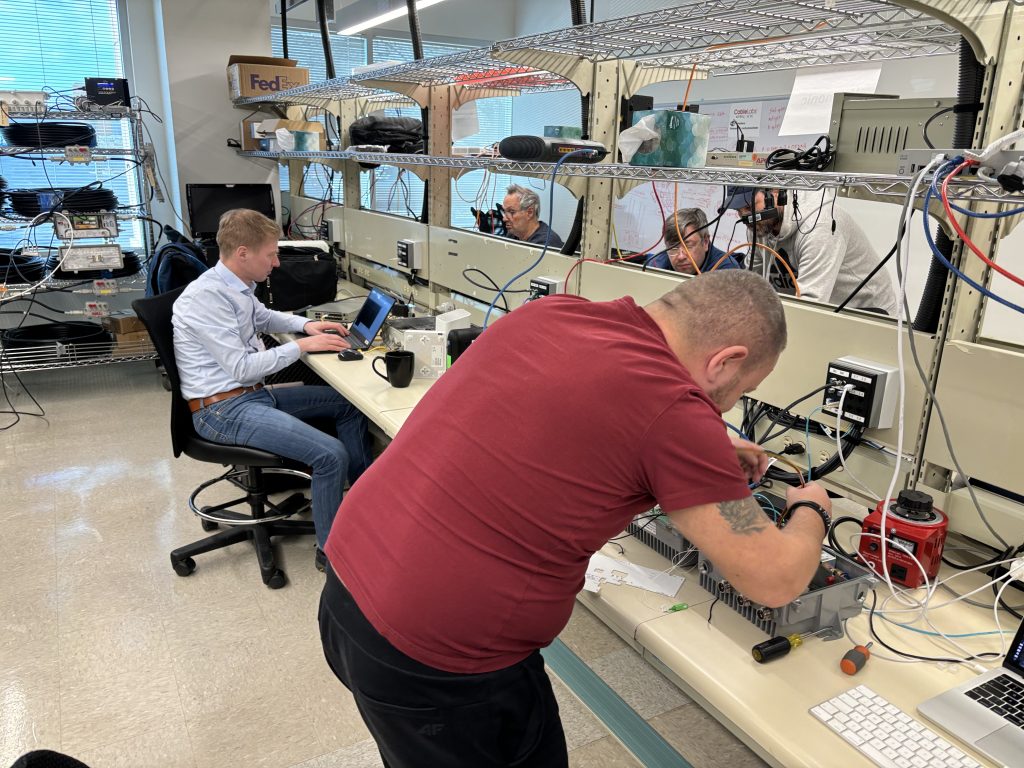
Above, engineers collaborate during the first combined DOCSIS 4.0 Interop•Labs event hosted by CableLabs and its subsidiary, Kyrio.
Interestingly, the interop illustrated how the traditional cable modem termination system (CMTS) has been disrupted by virtualization. Provided by one supplier, the CMTS used to be one box that did it all. Now, the software components have been abstracted into a virtual core that runs on servers in our data center, while the physical-layer components have migrated to the fiber node. This virtual architecture provides both better scalability and improved flexibility for the software, as well as better physical-layer performance on the coaxial cable. And in between, the fiber-optic cable uses much more scalable digital Ethernet connections.
The interop also demonstrated that the core and fiber node components can come from different suppliers because that interface is described in the CableLabs Remote PHY specifications. Looking at interoperability from all angles benefits all stakeholders. Interoperability enables a larger market in which suppliers can compete, which leads to varying competitive strategies and healthier ecosystems. Interoperability gives operators the confidence to plan large installations and the certainty that the equipment they put in the field this year will work for years to come.
Remote PHY interoperability events began in 2017 with DOCSIS 3.1 technology, so these solutions have been in the field for years and have matured. This interop shows that the migration to DOCSIS 4.0 technology is both very far along and proceeding smoothly — and that the supplier community has embraced interoperability among system components.
It's About Network Cohesion
The integration and optimization of the DOCSIS 4.0 ecosystem is underway. The goal has moved beyond simply booting DOCSIS 4.0 modems. Rather, we’re putting together all the parts, mixing and matching from different suppliers, demonstrating interoperability across the interfaces defined in CableLabs specification and achieving the multi-gigabit speeds and other advanced capabilities of DOCSIS 4.0 technology such as security, low latency and proactive network maintenance.
Other parts of the DOCSIS 4.0 ecosystem are also becoming available, including hybrid fiber coax (HFC) network equipment such as amplifiers, taps and passives.
To learn more about this exciting evolution, join us next month at CableLabs Winter Conference. This exclusive event for CableLabs members and the NDA vendor community will explore DOCSIS technology in two powerful sessions: “Unleashing the Full Potential of the DOCSIS 4.0 Network” and “A Vendor Perspective on DOCSIS 4.0 Technology Implementation.” You’ll hear from industry leaders about effective strategies, opportunities and benefits of the DOCSIS 4.0 network. Join us!

DOCSIS
Focus Shifts to Network Reliability in DOCSIS 4.0 Interop·Labs Event
CableLabs and Kyrio hosted a DOCSIS® 4.0 Interop·Labs event November 6–9 at our headquarters in Louisville, Colorado. It was a busy, week-long experience that highlighted multiple facets of DOCSIS 4.0 technology, and the many suppliers involved worked together to make it a success.
The primary focus of the event was network reliability — in particular, DOCSIS 4.0 cable modem (CM) proactive network maintenance (PNM) functions in DOCSIS 4.0 cable modem termination systems (CMTSs). There also were Remote PHY Device (RPD) interoperability exercises.
At this interop, four DOCSIS 4.0 CMs from four suppliers were interconnected to both DOCSIS 4.0 and DOCSIS 3.1 CMTSs from three companies. Participating suppliers were Arcadyan, Casa Systems, DCT-DELTA, Harmonic, Sagemcom, Ubee Interactive, and Vecima Networks. Rohde & Schwarz also participated with its DOCSIS 4.0 test system. Operators attended to observe the interop and talk about their DOCSIS 4.0 technology plans.
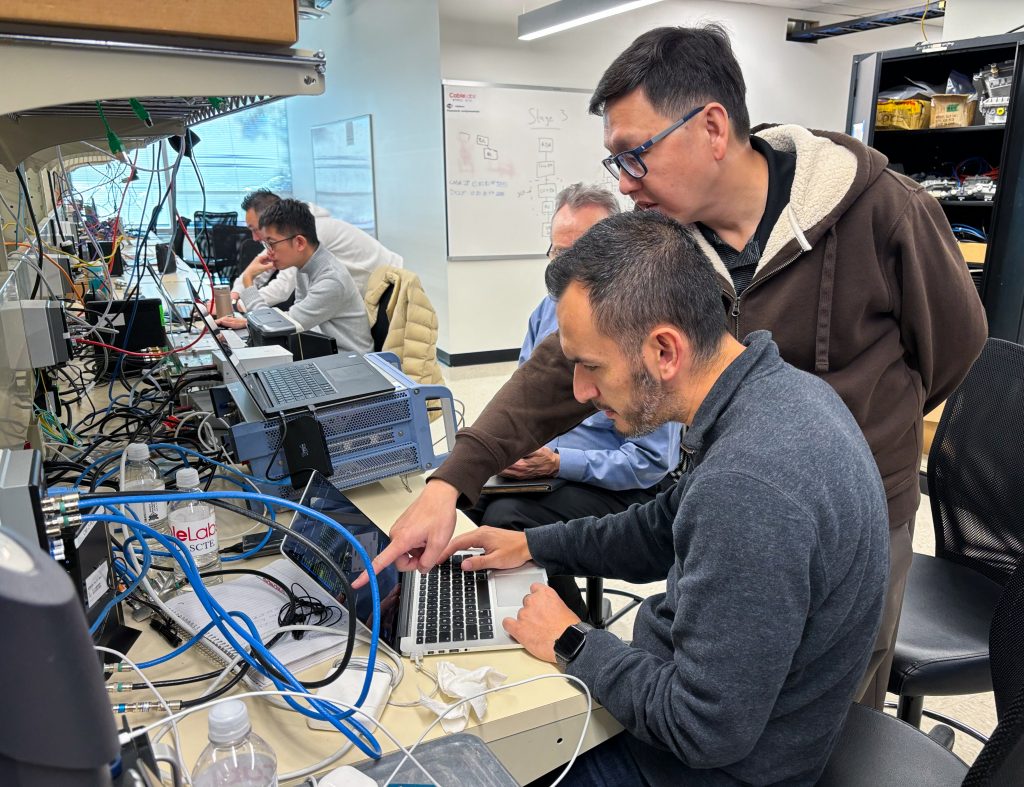
Engineers collaborate in a DOCSIS 4.0 Interop·Labs event at CableLabs' headquarters in November.
Network Reliability at the Forefront
Every day, hundreds of millions of broadband consumers use DOCSIS technology, and they depend on a reliable connection. DOCSIS PNM, which uses data provided by DOCSIS equipment, is foundational to the reliability of that connection.
For operators to keep tabs on the network and their offered services, data elements need to be both available and accurate. The goal of PNM is to fix issues before customers even realize there is a problem — before any service impacts occur.
PNM technology can be summarized into three areas: data collection, algorithms that use the data to analyze the network, and network operations to ensure continuous service.
Data collection. DOCSIS equipment generates vast amounts of network performance data to detect and measure issues within the cable plant. What kind of data? Data about both downstream and upstream RF performance, data on the spectrum in use, data on the signals on the coaxial cable, data on how the transmitters and receivers are operating, and more. At the interop event, we verified that the data reporting is both there and correctly formatted. For operator systems to use that data effectively, it has to be standardized in order for every modem from every manufacturer to report apples-to-apples information so that operator systems can use that data effectively.
Analysis algorithms. Once data is collected from the CMs, it’s run through algorithms to examine the health of the network. Systems sift through this data constantly, looking for anomalies. At the interop, the algorithms were discussed and compared, with operators describing how the data is used and what is being looked for.
Network operations. The DOCSIS PNM team maintains a reference document that describes how the data must be formatted, how it can be collected and which algorithms can be run on the data. Numerous SCTE Cable-Tec Expo papers discuss how to interpret the data and use it to maintain the network at the highest levels of service. The interop event featured eight high-runner PNM tests, collecting data from the DOCSIS equipment and putting it through algorithms. In the lab, it’s possible to simulate errored network conditions and use the data and algorithms to verify the condition of the network. SCTE is also involved with preparations for DOCSIS 4.0 tools and deployments, as Jason Rupe describes in the blog post “Ready, Set, 4.0: Tooling Up for DOCSIS Technology’s Rollout.”
A Comprehensive DOCSIS 4.0 Interop Event
Attending the event was one participant’s DOCSIS 4.0 virtual core platform and fiber node, which included a DOCSIS 4.0 extended spectrum DOCSIS (ESD) remote PHY device (RPD). This solution was a DOCSIS 4.0 ESD CMTS, and the DOCSIS 4.0 CM suppliers were excited to work with it. The DOCSIS 4.0 ESD CMTS operated both on a DOCSIS 4.0 ultra-high-split as well as up to 1.8 GHz on the coaxial cable. Both speed testing and security testing were examined against the DOCSIS 4.0 CMTS, continuing the work from previous interop events.
Remote-PHY Interop Exercises
DOCSIS 4.0 technology requires a distributed access architecture (DAA). At this interop, suppliers exhibited an array of DOCSIS 4.0 virtual cores. One supplier, which manufactures fiber nodes and RPDs, brought its DOCSIS 3.1 RPD with enhanced DOCSIS 3.1 capabilities. CableLabs and Kyrio were ready to support this kind of interop too. In essence, then, this wasn’t merely a DOCSIS 4.0 interop, but also a Remote PHY interop!
Collaborative DOCSIS Technology Evolution
At the DOCSIS 4.0 Interop·Labs event, CMTS and CM suppliers continued their efforts to verify that their equipment works together, further peeling the onion and diving into the nitty-gritty details of the specifications. This is where interoperability really happens.
All of the participants, along with us at CableLabs, left with a stronger understanding of product functionality and multi-vendor interoperability — and new work to do. Moving forward, the suppliers will continue to collaborate to refine their products and add further functionality.
Interop events are a major step toward large-scale deployment of DOCSIS 4.0 technology. Another step is certification. To find out more about Cable Modem Certification, click the button below.

DOCSIS
DOCSIS 4.0 Technology Makes Waves From SCTE Cable-Tec Expo to Launch
If you attended SCTE Cable-Tec Expo last month in Denver, you likely heard quite a bit about DOCSIS® 4.0 technology. In many sessions, on the Expo show floor and in countless conversations in between, the message was loud and clear: The era of DOCSIS 4.0 networks is here.
While we were hearing about the technology at Expo, the world’s first DOCSIS 4.0 network services were being introduced to customers just down the road in Colorado Springs. The new services from Comcast offer symmetric speed tiers of up to 2 Gbps downstream and upstream.
The Colorado Springs launch and subsequent deployment this week in Atlanta mark an exciting leap forward for cable operators and vendors in their path toward enabling a powerful 10G future. In addition to delivering faster symmetrical speeds, the 10G network will offer more reliability, lower latency and enhanced security.
Cable-Tec Expo offered proof that DOCSIS 4.0 technologies are ready to provide cable operators with what they need to begin offering 10G services. Online streaming of many Expo sessions is available to attendees through November 20, but I’ve recapped some of my most valuable takeaways below. What were you most excited to hear about? Leave a comment below to join the conversation.
Cost-Effective Upgrade Paths
Vendors and operators showcased product developments for cost-effective DOCSIS 4.0 technology upgrades, making upgrading existing hybrid fiber coax (HFC) networks an attractive and competitive choice compared with expensive fiber upgrades. Comcast demonstrated modular DOCSIS 4.0 full-duplex amplifiers and nodes, allowing for easy field upgrades. Operators also demonstrated services that combine DOCSIS 4.0 modems and DOCSIS 3.1 network gear, enabling new fiber-like speed tiers while phasing plant investment.
A Growing Ecosystem
Cable-Tec Expo highlighted a vibrant DOCSIS 4.0 technology ecosystem with the demonstration of a wide variety of nodes, amplifiers and customer premises equipment (CPE), which either have been announced or are available now. MaxLinear announced its Puma8 Extended Spectrum DOCSIS (ESD) chipset for DOCSIS 4.0 technologies, creating silicon choice for the ecosystem.
Flexibility and Interoperability
Exhibits at Expo demonstrated vendor and operator flexibility and growing efforts throughout the ecosystem to minimize complexity. Broadcom and Comcast announced a combined ESD/Full Duplex DOCSIS (FDX) chipset for DOCSIS 4.0 technologies, enabling operation in both modes and with embedded AI and ML capabilities to improve network maintenance. Vendors showcased modular nodes that give operators more options by enabling both DOCSIS technology and passive optical networking (PON) services in the same service groups.
AI and Machine Learning
It’s no surprise that AI and ML played a significant role at the conference. Vendors and operators are leveraging the technologies for proactive network maintenance and spectrum management to boost network reliability and efficiency.
The Future of 10G and DOCSIS 4.0 Technologies
SCTE Cable-Tec Expo 2023 demonstrated the readiness of DOCSIS 4.0 technologies, which offer cable operators a cost-effective and rapid pathway to launch 10G services. These next-generation services are supported by a growing ecosystem and operational improvements that are made possible by advanced technologies like AI and ML.
The evolution toward 10G and its limitless potential begins with DOCSIS 4.0 networks. Welcome to the journey.

DOCSIS
Ready, Set, 4.0: Tooling Up for DOCSIS Technology’s Rollout
DOCSIS® 4.0 deployment is almost here. Are you ready?
Fortunately, CableLabs is getting more prepared every day. A DOCSIS 4.0 Tools and Readiness working group has been hard at work, focused solely on this new technology and aiding operators in deploying it. The working group, part of SCTE’s Network Operations Subcommittee, has been preparing for deployment for several months and will continue that work as the industry learns more about how to build, deploy and operate services on DOCSIS 4.0 networks.
CableLabs, SCTE, and several operators and vendors are collaborating to assure timely delivery of available knowledge to assist operators as they prepare to deploy DOCSIS 4.0 technology. And that technology is almost here.
In July, CableLabs completed an Interop·Labs event to prove DOCSIS 4.0 cable modems can function as intended with DOCSIS 3.1 cable modem termination systems (CMTSs). Anticipating this development, CableLabs and industry colleagues — many of whom participate in SCTE Working Group 5 (WG5) — released a public document that shared our knowledge thus far and our plans for future development of capabilities and tools.
Proactive DOCSIS 4.0 Strategies
WG5’s report, “Cable Operator Preparations for DOCSIS 4.0 Technology Deployment,” assumes that the technology is not readily available yet, so the technology addresses what operators can do now to prepare. It focuses on network operations, covering early preparations and assessment of network segments and customers. The report also dives deeper into details to find the best early implementation locations and discusses how to make use of information available from the existing DOCSIS 3.1 networks.
With this technical report, we’re helping the cable community prepare their networks and operations for this new technology, which will enable the 10G platform of the future. Operators are already getting started.
“DOCSIS 4.0 represents a significant technological step forward,” said Will Berger, vice president of Telemetry Development for Charter Communications, a CableLabs member company. “By preparing now, operators can gain a valuable head start on what will be a collective challenge for the industry. While the technical aspects of this evolution are well-known, the opportunity to gain valuable operational preparation time is critical to ensuring a smooth transition to the 10G future.”
So, what happens next? WG5 is focusing on several important problems that we expect could emerge in early deployments of DOCSIS 4.0 technology. Some of these issues include:
- Interference due to higher transmission levels.
- Noise that occurs in new frequencies and new directions in the access network.
- Frequencies that are blocked due to legacy hardware in the network.
- Signal impairments that might reveal themselves at higher frequencies or at higher power.
- Leakage that might occur at new frequencies and interfere with new higher-frequency bands.
- How to operate new amplifiers and echo cancelers.
- How to manage the profiles in this new and complex network technology.
In addition, as we learn the severity and nature of any problems in these areas, we’ll be thinking about how to use our existing tools as well as what other tools we’ll need to develop to maintain our networks at the high degree of quality needed to support DOCSIS 4.0 services.
Collaborating for Industry Impact
If all this seems daunting, you’re right. In fact, we could use your help. If you’re in the cable industry, consider joining and contributing your knowledge and expertise to the working group. It’s an opportunity to learn at the earliest possible time what problems are becoming most significant, which methods are working or not working, which techniques may be automated into tools and which approaches require new vendor tools.
Working groups are part of the SCTE Standards program, a resource that is available to employees of our member companies as part of the complimentary CableLabs All Access Benefits program. To learn more and join the DOCSIS 4.0 Tools and Readiness working group, click the button below.
As you work to prepare and operate DOCSIS 4.0 technologies in your network, give yourself a head start by learning from others what works and what doesn’t. Better yet, share your ideas to get feedback faster and focus your efforts, while also helping others along the challenging path of technology evolution.
Also, for more about optimizing our networks, join “PNM Live!,” a panel discussion at SCTE® Cable-Tec Expo® on October 18. Experts, including CableLabs’ Jason Rupe, will discuss proactive network maintenance and how we can solve problems before customers are impacted.

DOCSIS
Security Gets the Spotlight at DOCSIS 4.0 Interop·Labs Event

CableLabs and Kyrio hosted a second DOCSIS® 4.0 Interop·Labs Event August 14–17 at our headquarters in Louisville, Colorado. This event built on our successes in July, focusing on interoperability between DOCSIS 4.0 cable modems (CMs) and DOCSIS 3.1 cable modem termination systems (CMTSs).
Attendance was up from the July interop, along with the addition of more CMs, CMTSs and test equipment. For this interop, seven DOCSIS 4.0 CMs from four suppliers were interconnected to seven DOCSIS 3.1 CMTSs from five companies. Participating suppliers were Arcadyan, Casa Systems, Cisco, CommScope, Harmonic, Sagemcom, Ubee Interactive, Vantiva and Vecima. EPIDoX.solutions and Rohde & Schwarz also attended with DOCSIS 4.0 test systems. Operators attended to observe the interop and talk about their DOCSIS 4.0 technology plans.
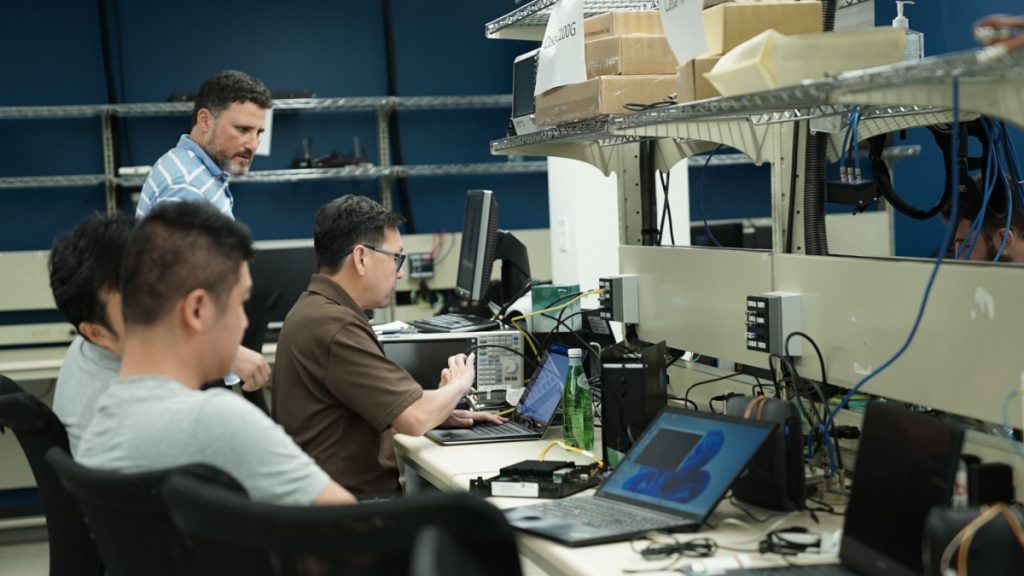
Engineers collaborate August 15 at the CableLabs DOCSIS 4.0 Interop·Labs Event.
Securing Customer Data Is Essential
The focus of this interop was security. Every day, tens of millions of broadband users connect with DOCSIS technology, using it for everything from ordering a pizza to sharing a video, from remote learning and remote medical appointments to purchasing household items and booking family vacations. Security in these activities is paramount to ensuring the best broadband experience possible.
Here’s an interesting tidbit about DOCSIS security: The methods we use at CableLabs are all published and available to the public — and always have been. DOCSIS security doesn’t depend on the secrecy of the implementation or its components. Rather, DOCSIS security is based on the strength of the algorithms and protocols in use, and these tools are updated from time to time to keep the security level high.
The security technologies are somewhat complex but can be summarized in two areas: authentication and encryption.
Authentication is as simple as the CM trusting the CMTS and the CMTS trusting the CM. It’s accomplished using digital certificates. DOCSIS technology has pioneered the use of public key cryptography on a mass scale. The DOCSIS public key infrastructure (PKI) is among the largest PKIs in the world, with half a billion active certificates issued and actively used every day.
Once authentication is complete and trust is established, the CM and CMTS exchange materials to encrypt the user traffic. Encryption makes the user traffic look like gibberish; without the means to decrypt the traffic, anyone snooping in on it would find it’s unintelligible. This methodology keeps users’ information secret.
As this Interop·Labs event examined interoperability with DOCSIS 3.1 CMTSs, it also looked at authentication and encryption, which are enabled by the Baseline Privacy Interface Plus (BPI+). A deeper dive on DOCSIS security capabilities can be found here, and further details about the cable security experience here.
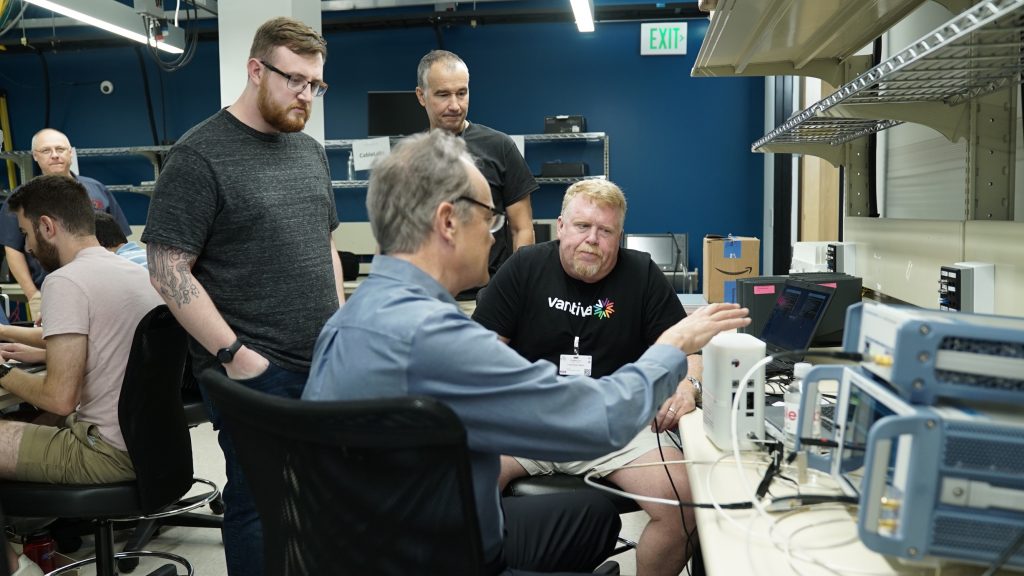
Engineers work together during the four-day event.
The Importance of Getting the Community Together
A big takeaway from the July interop was the importance of suppliers getting to know each other, creating relationships and collaborating ahead of this August interop. There’s been a lot of activity over this past month, at both CableLabs and supplier locations. The CableLabs security team was also busy ahead of time, working with suppliers to distribute materials and answer questions about DOCSIS security.
Because of this up-front work, we were able to get right to work on the August interop. With the latest products and software on hand, we stepped through all of the possible equipment combinations to explore how each worked to get CMs online with security.
Then, with security enabled, we again achieved the high speeds expected with DOCSIS 4.0 broadband — this time with line-rate encryption of the traffic. The highest downstream speeds were achieved with five 192 MHz OFDM channels (total of 960 MHz), which provided around 8.5 Gbps. On the upstream, a high-split channel lineup of QAMs and 2 OFDMA channels provided around 1.5 Gbps.
Everyone, including CableLabs, left the interop with new tasks to tackle, which is typically the case with maturing products and expected with events like these.
Overall, all of the participants left this interop in a good place, in terms of functionality and multi-vendor interoperability. From here, the suppliers can layer on additional functionality and add maturity to their products, working together in their own labs and at CableLabs.
Demonstrations at SCTE Cable-Tec Expo
The focus is now on successful technology demonstrations at the SCTE® Cable-Tec Expo® in October, in Denver, Colorado. Our experts will be on hand at booth 2201, so make plans to stop by if you’re attending.
We’re planning another in-person interop at CableLabs after Cable-Tec Expo. We’re actively working with the supplier community on both the timing and topics for this next interop. Stay tuned for more information.

DOCSIS
DOCSIS 4.0 Interop·Labs Event Draws Excellent Participation

For the first time since we published the DOCSIS® 4.0 specifications in 2020, the DOCSIS community recently came together for an Interop•Labs event. With Kyrio support, CableLabs hosted the interop July 17–21 at our headquarters in Louisville, Colorado. The event was a success on multiple fronts, and I was particularly excited by the strong turnout from suppliers and operators.
Both cable modem termination system (CMTS) and cable modem (CM) suppliers began the work to bring this technology to the field. For the in-person event, suppliers brought more than a dozen products to our lab. Operators also attended to observe, provide encouragement and offer operational perspectives.
The Importance of DOCSIS 4.0 Interoperability
In our lab, CableLabs provided an environment for all this equipment to come together — with a focus on the DOCSIS 4.0 specifications that are so important for interoperability. Interoperability allows:
- Suppliers to compete in a larger market.
- Operators to have more choices in the services they offer to subscribers.
- Competition and innovation to occur among a larger community of smart people.
It really is the cornerstone of what CableLabs and Kyrio bring to the table for the DOCSIS specifications.
Interoperability is pretty tricky to achieve and takes attention to details contained in the specifications. The CMTS and CM must both interpret and agree on a number of parameters to work together to provide service (e.g., the downstream and upstream channels that a CM can use). This sometimes comes down to an interpretation of the specification — expertise that’s right in CableLabs’ wheelhouse.
Pair, Re-Pair, Repeat: How the Interop Unfolded
For this interop, six DOCSIS 4.0 CMs from four suppliers were interconnected to six DOCSIS 3.1 CMTSs from five companies. Participating suppliers were Arcadyan, Casa Systems, Cisco, CommScope, Harmonic, Sagemcom, Ubee, Vantiva and Vecima. EPiDoX also attended with a prototype DOCSIS 4.0 test system.
The CMTS and CM suppliers iteratively paired CMs to CMTSs to test interoperability. During this pairing and re-pairing, participants investigated the functionality and interoperability of the CM and CMTS equipment against the DOCSIS specification requirements. This process ensured all connectivity options between the CMs and the CMTSs were investigated.
Suppliers worked diligently to meet the goals of the interop and then went the extra mile to pursue “stretch” goals. Everyone came prepared with a collaborative attitude.
The cable modems successfully connected to CMTSs the first time, which was reassuring because DOCSIS 4.0 technology can be seen as an extension of DOCSIS 3.1 technology. We discovered some issues, of course, and everyone — including CableLabs — left the interop with something to work on. This is par for the course for a first interop, and it’s exactly the reason we hold these events.
And, yes, the DOCSIS systems we investigated passed high-speed traffic. Very high speed, as in gigabits-per-second downstream and upstream. For me, a long-time DOCSIS expert who still remembers dial-up speed, DOCSIS 1.0 speeds and everything since, it really was quite amazing to witness the speeds that DOCSIS 4.0 technology makes possible. This included DOCSIS 3.1 CMTSs augmented with additional channels to support DOCSIS 4.0 modems, as referenced in this earlier blog post.
The Interop•Labs event also let me get reacquainted with several colleagues that I hadn’t seen in several years; it was good to refresh those friendships and working relationships. There were new faces, too — at least to me — and I got to meet and work with those folks, as well.
Marching Ahead to DOCSIS 4.0 Availability
Another in-person interop is scheduled for August 14–17, again at CableLabs’ Louisville office. We expect the same participants, and we’ll revisit the scenarios from July and take a look at some new ones. The goal is to keep pushing a more rigorous and deeper understanding of the DOCSIS 4.0 specifications and product maturity.
Although speed is fun to witness, the areas of lower latency, enhanced security and increased reliability are co-equal pillars of the 10G network and are all supported by DOCSIS 4.0 specifications. DOCSIS 4.0 technology is going to blow some minds when it gets unleashed, and it will raise the bar for consumer broadband higher than ever.
After the August interop, our focus will turn to the SCTE® Cable-Tec Expo® in October in Denver. Believe me: You’ll want to attend and see these developments for yourself. The industry is focused on bringing DOCSIS 4.0 technology to market, and it will be all over the show floor — including the hybrid fiber-coax (HFC) network equipment. End to end, suppliers have been working overtime to make this event a showcase. You won’t be disappointed.

DOCSIS
Inaugural DOCSIS 4.0 Interop Event Sets Stage for Interoperability Testing

Key Points
- The future of the cable industry relies on interoperability to deliver what consumers need.
Consumers are demanding increasingly immersive, interactive media experiences that require faster speeds, lower latency, increased network reliability and enhanced security. The future of the cable industry relies on interoperability to deliver what consumers need. That’s the goal of the industry’s full-court press toward 10G deployment, and it starts with DOCSIS® 4.0 compliance.
DOCSIS 4.0 Equipment Functionality
The DOCSIS 4.0 specifications were completed in early 2020. Since then, a lot of hard work has led to getting DOCSIS 4.0 cable modems and cable modem termination systems (CMTSs) ready for a first look. Last spring, CableLabs hosted a 10G Showcase at our Louisville, Colorado, office with impressive results. Now, the industry is ready to take the next step.
CableLabs and Kyrio will host an in-person DOCSIS 4.0 Interop·Labs event July 17–20 in Louisville. DOCSIS Interop·Labs events are a precursor to modem certification and provide suppliers an opportunity to test their products in a multi-vendor environment with state-of-the-art equipment to meet the letter of the specifications. Operators also will attend to get a look at the equipment and the environments, and to network with their industry peers on the operator and the supplier sides.
What can be expected from this event? Because this is early equipment with basic functionality, our goals include looking at basic functions, including whether a cable modem can become operational in the common configurations in use today. When a modem becomes operational, it will be exercised with back-office systems and data traffic.
The four-day Interop·Labs event will ensure that the fundamentals of interoperability are in place and capable of supporting subsequent interoperability events that will look deeper into modem functionality. The event also will focus on backward compatibility to build confidence that a DOCSIS 4.0 modem can be deployed on existing headend equipment and operations systems to provide the opportunity for faster speed tiers on DOCSIS 3.1 headend equipment. A DOCSIS 4.0 modem on a DOCSIS 3.1 CMTS will be an exciting milestone for the industry.
Since the CableLabs 10G Showcase last spring, CableLabs and Kyrio have upgraded the labs to support faster speeds to enhance the customer experience with cable broadband.
Cable Modem Certification
This Interop event has great synergy with the recent launch of the CableLabs DOCSIS 4.0 Cable Modem Certification program. Initial cable modem certification testing will focus on verifying operation on DOCSIS 3.1 systems, and this Interop·Labs event will provide suppliers an opportunity to see how their solutions work with others. Find more information on the CableLabs certification program here.
Gaining Momentum and Planning More DOCSIS Interop Events
Future DOCSIS Interop·Labs are planned to look deeper into the other three pillars of 10G: enhanced security, lower latency and network reliability. Our DOCSIS 4.0 Interop·Labs and Certification work is just beginning, and you can look forward to additional blog posts to keep you up to date with what is happening at CableLabs and Kyrio. And, with the Interop·Labs event being hosted in July, you can be sure this equipment will be on the show floor at the SCTE Cable-Tec Expo in October in Denver.

DOCSIS
DOCSIS Technology Ramps Up Speed

Thanks to two recent innovations, DOCSIS technology is bringing more speed to the table. First, DOCSIS 3.1 cable modem termination systems (CMTSs) can now offer more DOCSIS channels than they did just a few years ago. Second, DOCSIS 4.0 cable modems (CMs) can take advantage of those extra channels to provide even faster speeds. DOCSIS is the gift that just keeps on giving.
DOCSIS Expansion
As you can see in the middle row of the figure below, the original DOCSIS 3.1 systems (circa 2016) supported about 5 Gbps of downstream speed. Technically speaking, this includes 2 orthogonal frequency-division multiplexing (OFDM) downstream channels and 32 single-carrier quadrature amplitude modulation (QAM) channels.

As you see in the figure’s top row, upgraded DOCSIS 3.1 CMTSs (which are available now from multiple suppliers) can support a peak downstream speed of 8.8 Gbps by utilizing as many as 4 OFDM channels and 32 QAM channels.
Finally, illustrated in the figure’s bottom row, a DOCSIS 4.0 CM can use all the channels available with an upgraded DOCSIS 3.1 CMTS (actually more, as you’ll see in a moment). That means cable operators can almost double the downstream speed of their DOCSIS system by using a DOCSIS 4.0 CM on a DOCSIS 3.1 CMTS.
Faster Speeds
Confirming the strong performance of DOCSIS 4.0 technology, a recent press release about a live network field trial claimed that up to 15 Gbps of downstream speed is possible with a DOCSIS 4.0 CMTS and a DOCSIS 4.0 CM. This is possible because a DOCSIS 4.0 CMTS will provide even more capacity, supporting at least 6 and as many as 8 OFDM channels when complemented with an outside plant extending beyond 1.2GHz. This number is in line with DOCSIS 4.0 predictions of up to 16 Gbps of aggregate capacity.
How can one even quantify this explosion in speed? We’re talking about a leap from 5 Gbps to up to 15 Gbps downstream. This ensures support for evolving use cases that consume more and more downstream bandwidth. And once again, DOCSIS technology is up to the task, providing a useful roadmap of speed for the next generation of broadband applications.
How It’s Happening
To make this update to the DOCSIS 3.1 CMTS happen, suppliers are reusing a technology called channel bonding, which was added in the DOCSIS 3.0 specifications. The original DOCSIS 3.0 equipment supported 4 bonded downstream QAM channels (in North America, each 6 MHz wide), and the next generation of equipment supported 8, then 16, then 24 and finally 32 bonded downstream QAM channels.
DOCSIS 3.1 CMTSs are going through a similar evolution, evolving from bonding the original 2 OFDM channels (each up to 192 MHz wide) to 4 or more OFDM channels. And DOCSIS 4.0 CMs can use all these channels, which was part of the plan when the DOCSIS 4.0 specifications were developed. Channel bonding is a powerful tool—even more so now when using 192 MHz wide OFDM channels.
Utilizing the ability to bond additional OFDM channels when operating a DOCSIS 4.0 CM on a DOCSIS 3.1 CMTS not only supports more capacity, and therefore enhanced benefits for consumers; it also gets those benefits to consumers much sooner. Operators can confidently deploy DOCSIS 4.0 CMs with enhanced service offerings as soon as they’re available, and then transition to DOCSIS 4.0 CMTSs as appropriate.
The Importance of Community
The DOCSIS supplier community deserves a shout-out! Once again, suppliers have provided cable operators with an appealing method to transition to the next generation of DOCSIS technology by getting started with DOCSIS 4.0 CMs on now familiar and near-ubiquitous DOCSIS 3.1 CMTSs. Suppliers and operators are collaborating on smart ways to transition to a DOCSIS 4.0 network; using a more capable DOCSIS 3.1 CMTS should be an attractive option.
CableLabs has been upgrading our labs to support this speed explosion. We’ve recently added new testing capabilities ranging from RF testing to enhanced traffic-generation capability to support the capabilities of DOCSIS 4.0 technology. Utilizing upgraded DOCSIS 3.1 CMTSs, CableLabs is very excited to work with DOCSIS 4.0 CMs to prove both the interoperability of the systems and the speeds that are possible.
DOCSIS® 4.0 Certification
To support the deployment of DOCSIS 4.0 CMs, CableLabs and Kyrio are kicking off the DOCSIS 4.0 Cable Modem Certification Program this summer. Starting June 26, modem suppliers can submit DOCSIS 4.0 modems for DOCSIS 4.0 certification testing, which will include testing with DOCSIS 3.1 infrastructure such as virtual CMTSs, Remote PHY Devices (RPDs) and Remote MACPHY Devices (RMDs).
Have any questions about DOCSIS 4.0 certification? You can find further details on Kyrio’s CableLabs Certification webpage (which includes a FAQ and guidelines).

DOCSIS
How DOCSIS® 4.0 Technology Is Enabling The Next Generation of Broadband
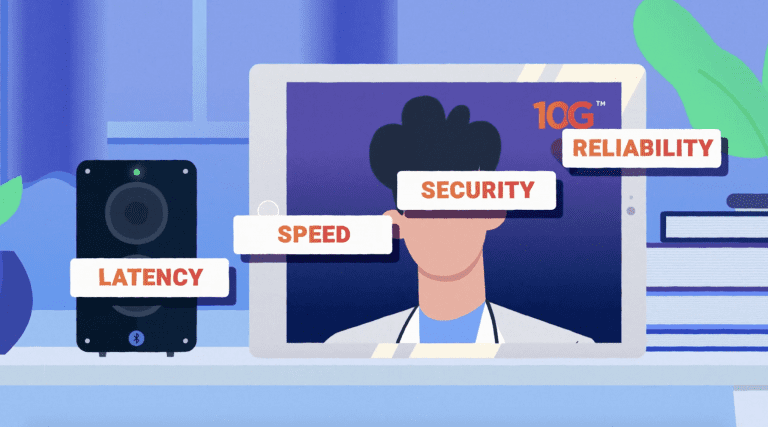
Broadband just got better as cable delivers on the 10G Platform with DOCSIS® 4.0 technology that is not only faster but more cost-effective.
These speeds will allow consumers to access the next generation of higher bandwidth customer applications that allow for improved telework, education, gaming, health care, social interaction, and virtual reality (VR) and augmented reality (AR). There is so much that faster broadband will bring to consumers.
And speed is not the only focus of the 10G platform. DOCSIS 4.0 will improve consumers’ cable broadband experience through:
- Increased network security because the bad actors are out there. DOCSIS 4.0 technology provides several approaches that help reduce the risk of data loss, theft, and sabotage, with the goal to build consumer trust in the cable broadband network.
- More reliable connectivity because the cable broadband network is resilient, self-monitoring and self-healing. Technological advances keep it working without sudden glitches, slowdowns, freezing and other annoying interruptions. Consumers can get more done with cable broadband.
- Lower latency technology will spur a wave of innovation, enabling better gaming and seamless next-level experiences like holodecks, light field displays and 360° video. Learn more about low latency DOCSIS technology and read about how Kyrio certified the first low latency DOCSIS 3.1 modem this year.
There are no new wires to bury or trenches to be dug. Consumers will reap the benefits immediately because DOCSIS 4.0 uses the same cable network that not only pioneered broadband but has continually provided high-quality and reliable services.
CableLabs is hosting DOCSIS 4.0 interoperability events as DOCSIS 4.0 technology positions the cable broadband network to meet consumer needs for the next wave of broadband. These are significant steps towards realizing the cable 10G Platform.


DOCSIS
Interop·Labs for DOCSIS® 4.0 Technology

On behalf of CableLabs, Kyrio will be hosting upcoming DOCSIS 4.0 interoperability events!
DOCSIS 4.0 technology is the next evolution of the HFC network, moving the industry towards the 10G vision and offering multigigabit symmetric services as well as low latencies over the network.
As vendors work to create the development of DOCSIS 4.0 products, CableLabs and Kyrio are busy preparing for the next phase of technology development: conducting interoperability events. CableLabs has established a rigorous process for technology development starting with DOCSIS 1.0 technology and ultimately leading to the robust ecosystem that exists today. The company’s proven approach has worked successfully at CableLabs for the past 24 years:
Phase 1 Phase 2 Phase 3

Phase 1 is the specification stage, when CableLabs, members and vendors come together to collaborate on defining the DOCSIS technology. Phase 1 for DOCSIS 4.0 was completed in 2019, when the specifications were written and suppliers have began implementation.
Phase 2 is when interoperability events (aka interops) occur at CableLabs in Louisville, Colorado to make sure that systems work together. As the term implies, interops are held to ensure that components of a DOCSIS system — including the base technology, security and support — are interoperable for easy installation and proactive customer care.
For DOCSIS 4.0 technology, CableLabs will be prepared to host the first interop event this year after SCTE Cable-Tec Expo 2021 in Atlanta, where the show floor promises to hold several DOCSIS 4.0 technology demonstrations.
At this time, 12 DOCSIS 4.0 interoperability events are planned to begin in October 2021 and will run through December 2022. This near-monthly spacing will give suppliers the opportunity to attend, learn and then run a sprint to add new functionality for the next interop.
The early interops focus on basic functionality of the DOCSIS chipsets. As the schedule progresses, the focus will shift to adding more software functionality. Always, the emphasis will be on interoperable solutions, including the cable modem, cable modem termination system (CMTS) and software support systems. Going forward, the interops will include Remote PHY and Remote MACPHY devices.
Interoperability gives operators the confidence to plan large installations and the certainty that the equipment they purchase today will also work tomorrow. Customers can buy a modem and take it with them if they move into a new cable territory, worldwide. Interoperability provides a larger market in which suppliers can compete, which, in turn, allows for healthier ecosystems and varying strategies.
Phase 3, the certification stage, will happen naturally as the interoperability process produces more mature products and systems. We’ll talk more about this phase when that time approaches.
The interop phase can be a fun, invigorating time. Some of us have been working on the DOCSIS project for two decades, and there are always new entrants. As we shift back to working in our offices post-pandemic, we’re all looking forward working face-to-face in the lab—all in the effort to bring forward the next generation of cable broadband and deliver on the 10G promise.
Interoperability is paramount to the DOCSIS ecosystem. The DOCSIS community is encouraged to once again come together for these upcoming interoperability events, contributing and collaborating to keep the DOCSIS 4.0 ecosystem healthy and sustainable. This fall, CableLabs will be ready!


